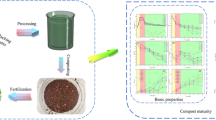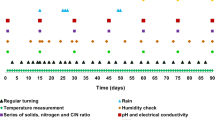Abstract
Composting is an attractive way to recycle organic wastes because the product (compost) can be used as an organic fertilizer or a culture substrate. This study assessed coal fly ash (CFA; at 0, 15, and 35%) and/or vinegar residue (VR; at 0, 35, and 55%) as additives in the green waste (GW) composting process. Compost maturity was assessed based on the following indicators: water-holding capacity, pH, total organic carbon, electrical conductivity, total Kjeldahl nitrogen, and germination index. Other important compost properties that were determined included germination percentage and root length of seeds in a germination assay, crude fiber degradation, specific UV absorption, E4/E6 ratio, microbial numbers (culturable bacteria and volatile fatty acid-degrading bacteria), enzyme activities (dehydrogenase, β-glucosidase, acid-phosphatase, urease, and ortho-diphenol oxidase), and available nutrients. When added together, CFA and VR improved all of these properties. As indicated by the maturity indicators and other properties, the best treatment (the combined addition of 15% CFA and 55% VR) required only 23 days to produce a mature and high quality compost.





Similar content being viewed by others
References
Akasaka N, Higashikubo H, Ishii Y, Sakoda H, Fujiwara S (2017) Polyamines in brown rice vinegar function as potent attractants for the spotted wing drosophila. J Biosci Bioeng 123:78–83
Alves CA, Font O, Moreno N, Vicente ED, Duarte M, Tarelho LAC, Querol X (2019) Mineralogical, chemical and leaching characteristics of ashes from residential biomass combustion. Environ Sci Pollut Res. In Press.
An CJ, Huang GH, Yao Y, Sun W, An K (2012) Performance of in-vessel composting of food waste in the presence of coal ash and uric acid. J Hazard Mater 203–204:38–45
Awasthi SK, Wong JWC, Li J, Wang Q, Zhang ZQ, Kumar S, Awasthi MK (2018) Evaluation of microbial dynamics during post-consumption food waste composting. Bioresour Technol 251:181–188
Belyaeva ON, Haynes RJ (2009) Chemical, microbial and physical properties of manufactured soils produced co-composting municipal green waste with coal fly ash. Bioresour Technol 100:5203–5209
Blissett RS, Rowson NA (2012) A review of the multi-component utilisation of coal fly ash. Fuel 97:1–23
Bohacz J (2019) Changes in mineral forms of nitrogen and sulfur and enzymatic activities during composting of lignocellulosic waste and chicken feathers. Environ Sci Pollut Res 26:10333–10342
Busato JG, de Carvalho CM, Zandonadi DB, Sodre FF, Mol AR, de Oliveira AL, Navarro RD (2018) Recycling of wastes from fish beneficiation by composting: chemical characteristics of the compost and efficiency of their humic acids in stimulating the growth of lettuce. Environ Sci Pollut Res 25:35811–35820
Castillo JM, Romero E, Nogales R (2013) Dynamics of microbial communities related to biochemical parameters during vermicomposting and maturation of agroindustrial lignocellulose wastes. Bioresour Technol 146:345–354
Chen LH, Yang XM, Raza W, Luo J, Zhang FG, Shen QR (2011) Solid-state fermentation of agro-industrial wastes to produce bioorganic fertilizer for the biocontrol of Fusarium wilt of cucumber in continuously cropped soil. Bioresour Technol 102:3900–3910
Ding Y, Wei JJ, Xiong JS, Zhou BW, Cai HJ, Zhu WQ, Zhang HJ (2019) Effects of operating parameters on in situ NH3 emission control during kitchen waste composting and correlation analysis of the related microbial communities. Environ Sci Pollut Res 26:11756–11766
Du NS, Shi L, Du LT, Yuan YH, Li B, Sang T, Sun J, Shu S, Guo SR (2015) Effect of vinegar residue compost amendments on cucumber growth and Fusarium wilt. Environ Sci Pollut Res 22:19133–19141
Fernandez-Gomez MJ, Romero E, Nogales R (2010) Feasibility of vermicomposting for vegetable greenhouse waste recycling. Bioresour Technol 101:9654–9660
Goering HK, Van Soest PJ (1970) Forage Fibre Analysis (Apparatus, Reagents, Procedures, and Some Applications). ARSUSDA, Washington, D.C.
Kchaou R, Baccar R, Bouzid J, Rejeb S (2018) The impact of sewage sludge and compost on winter triticale. Environ Sci Pollut Res 25:18314–18319
Kumar KV, Patra DD (2012) Alteration in yield and chemical composition of essential oil of Mentha piperita L. plant: effect of fly ash amendments and organic wastes. Ecol Eng 47:237–241
Koivula N, Räikkönen T, Urpilainen S, Ranta J, Hänninen K (2004) Ash in composting of source-separated catering waste. Bioresour Technol 93:201–299
Li L, Feng L, Zhang RH, He YF, Wang W, Chen C, Liu GQ (2015) Anaerobic digestion performance of vinegar residue in continuously stirred tank reactor. Bioresour Technol 186:338–342
Li YX, Pei GP, Qiao XL, Zhu YE, Li H (2018) Remediation of cadmium contaminated water and soil using vinegar residue biochar. Environ Sci Pollut Res 25:15754–15764
Liu J, Yuan XZ, Zeng GM, Shi JG, Chen S (2006) Effect of biosurfactant on cellulase and xylanases production by Trichoderma viride in solid substrate fermentation. Process Biochem 41:2347–2351
Lv BY, Xing MY, Yang J, Qi WS, Lu YS (2013) Chemical and spectroscopic characterization of water extractable organic matter during vermicomposting of cattle dung. Bioresour Technol 132:320–326
Manyapu V, Mandpe A, Kumar S (2018) Synergistic effect of fly ash in in-vessel composting of biomass and kitchen waste. Bioresour Technol 251:114–120
Mohee R, Boojhawon A, Sewhoo B, Rungasamy S, Somaroo Geeta D, Mudhoo A (2015) Assessing the potential of coal ash and bagasse ash as inorganic amendments during composting of municipal solid wastes. J Environ Manag 159:209–217
Morais FMC, Queda CAC (2003) Study of storage influence on evolution of stability and maturity properties of MSW composts. In: Proceedings of the Fourth International Conference of ORBIT Association on Biological Processing of Organics: Advances for a Sustainable Society Part II. Perth, Australia.
Mupambwa HA, Mnkeni PNS (2018) Optimizing the vermicomposting of organic wastes amended with inorganic materials for production of nutrient-rich organic fertilizers: a review. Environ Sci Pollut Res 25:10577–10595
Phua Z, Giannis A, Dong ZL, Lisak G, Ng WJ (2019) Characteristics of incineration ash for sustainable treatment and reutilization. Environ Sci Pollut Res 26:16974–16997
Rosen V, Chen Y (2018) Effects of compost application on soil vulnerability to heavy metal pollution. Environ Sci Pollut Res 25:35221–35231
Sen B, Chandra TS (2009) Do earthworms affect dynamics of functional response and genetic structure of microbial community in a lab-scale composting system? Bioresour Technol 100:804–811
Shaheen SM, Hooda PS, Tsadilas CD (2014) Opportunities and challenges in the use of coal fly ash for soil improvements –A review. J Environ Manag 145:249–267
Pandey VC, Singh N (2010) Impact of fly ash incorporation in soil systems. Agric Ecosyst Environ 136:16–27
Shi L, Du NS, Yuan YH, Shu S, Sun J, Guo SR (2016) Vinegar residue compost as a growth substrate enhances cucumber resistance against the Fusarium wilt pathogen Fusarium oxysporum by regulating physiological and biochemical responses. Environ Sci Pollut Res 23:18277–18287
Sun Y, Li M, Zhou H, Shan G, Cheng Q, Jungbluth KH, Buescher W, Maack C, Lipski A, Wang Z, Fan Y (2017) In situ measurements and simulation of oxygen diffusion and heat transfer in maize silage relative to the silo surface. Comput Electron Agric 137:1–8
Punjwani J, Krishna R, Kalpana S, Gupta KK (2011) Application impact of coal fly ash, and water hyacinth on cultivation of tomato. Int J Res Chem Environ 1:71–76
Ukwattage NL, Ranjith PG, Bouazza M (2013) The use of coal combustion fly ash as a soil amendment in agricultural lands (with comments on its potential to improve food security and sequester carbon). Fuel 109:400–408
Wang ZB, Shao SP, Zhang CS, Lu DL, Ma HL, Ren XF (2015) Pretreatment of vinegar residue and anaerobic sludge for enhanced hydrogen and methane production in the two-stage anaerobic system. Int J Hydrogen Energ 40:4494–4501
Wei ZM, Xi BD, Zhao Y, Wang SP, Liu HL, Jiang YH (2007) Effect of inoculating microbes in municipal solid waste composting on characteristics of humic acid. Chemosphere 68:368–374
Weishaar JL, Aiken GR, Bergamaschi BA, Fram MS, Fujii R, Kenneth M (2003) Evaluation of specific ultraviolet absorbance as an indicator of the chemical composition and reactivity of dissolved organic carbon. Environ Sci Technol 37:4702–4708
Wong JW, Fung SO, Selvam A (2009) Coal fly ash and lime addition enhances the rate and efficiency of decomposition of food waste during composting. Bioresour Technol 100:3324–3331
Wu JQ, Zhao Y, Zhao W, Yang TX, Zhang X, Xie XY, Cui HY, Wei ZM (2017) Effect of precursors combined with bacteria communities on the formation of humic substances during different materials composting. Bioresour Technol 226:191–199
Zhang L, Sun XY (2018a) Effects of waste lime and Chinese medicinal herbal residue amendments on physical, chemical, and microbial properties during green waste composting. Environ Sci Pollut Res 25:31381–31395
Zhang L, Sun XY (2018b) Evaluation of maifanite and silage as amendments for green waste composting. Waste Manag 77:435–446
Zhang L, Sun XY (2016) Improving green waste composting by addition of sugarcane bagasse and exhausted grape marc. Bioresour Technol 218:335–343
Zhang L, Sun XY (2014) Changes in physical, chemical, and microbiological properties during the two-stage co-composting of green waste with spent mushroom compost and biochar. Bioresour Technol 171:274–284
Zhang L, Sun XY, Tian Y, Gong XQ (2013) Effects of brown sugar and calcium superphosphate on the secondary fermentation of green waste. Bioresour Technol 131:68–75
Zhao QS, Li PP, Sun DM (2012) Effects of inoculating thermophiles and rhizopus on composting process of vinegar residue and their nutrients status. Adv Mater Res 518:68–72
Zhou Y, Selvam A, Wong JWC (2014) Evaluation of humic substances during co-composting of food waste, sawdust and Chinese medicinal herbal residues. Bioresour Technol 168:229–234
Zucconi F, Pera A, Forte M, de Bertoldi M (1981) Evaluating toxicity of immature compost maturity. Biocycle 22:54–57
Acknowledgments
We thank Prof. Bruce Jaffee for his linguistic modification of this paper.
Funding
This study was supported by the Fundamental Research Funds for the Central Universities (No. 2018ZY28) and the National Natural Science Foundation of China (No. 31700537).
Author information
Authors and Affiliations
Corresponding author
Additional information
Responsible editor: Ta Yeong Wu
Publisher’s note
Springer Nature remains neutral with regard to jurisdictional claims in published maps and institutional affiliations.
Rights and permissions
About this article
Cite this article
Zhang, L., Sun, X. The use of coal fly ash and vinegar residue as additives in the two-stage composting of green waste. Environ Sci Pollut Res 26, 28173–28187 (2019). https://doi.org/10.1007/s11356-019-05940-2
Received:
Accepted:
Published:
Issue Date:
DOI: https://doi.org/10.1007/s11356-019-05940-2




